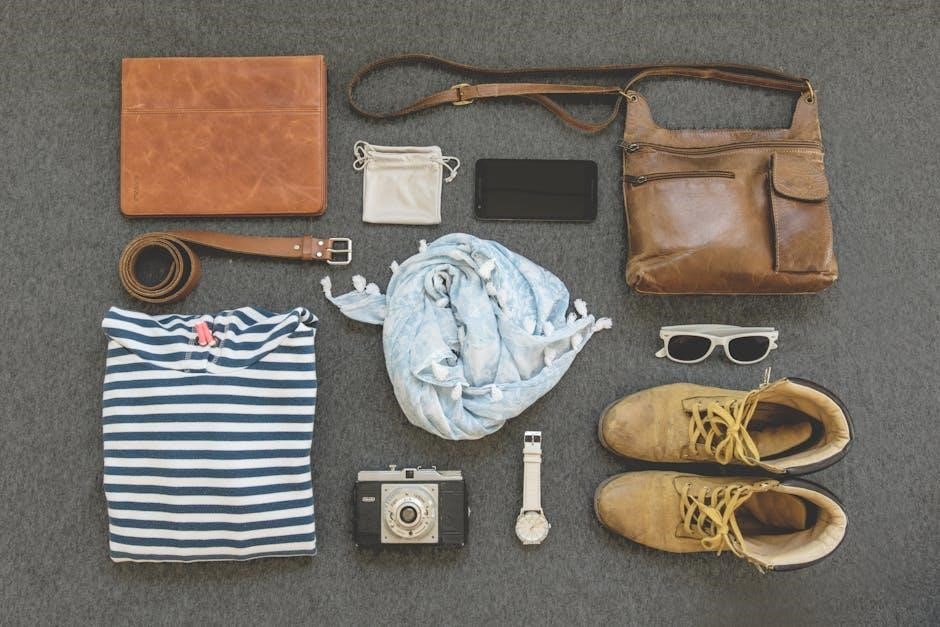Belt sizing is crucial for both aesthetics and comfort‚ ensuring a secure and polished look. While often overlooked‚ proper sizing makes a significant difference in overall appearance and functionality.
Why Proper Belt Sizing Matters
A well-fitted belt ensures comfort‚ functionality‚ and a polished appearance. Proper sizing prevents discomfort caused by belts that are too tight or too loose. A belt that’s too small can dig into your waist‚ while one that’s too large may slip or sag; Incorrect sizing can also affect the overall look of your outfit‚ making it appear ill-fitted. Additionally‚ a poorly sized belt can cause pants to droop or bunch up‚ compromising both style and practicality. Choosing the right size ensures your belt serves its purpose effectively while maintaining a balanced‚ put-together look. A good fit enhances both aesthetics and usability.
The Basics of Belt Measurement
Measuring for a belt involves determining the length from the buckle to the most frequently used hole. This ensures a comfortable fit and prevents excessive tail length. Using a flexible tape measure‚ wrap it around your natural waistline or hip area where the belt will sit. For accuracy‚ hold the tape snug but not too tight. If using an existing belt‚ measure from the buckle fold to the most worn hole. This method provides a precise fit‚ ensuring the belt neither digs into the skin nor slips excessively. Proper measurement is key to selecting the ideal size for comfort and style.
Understanding Belt Sizes
Belt sizes are typically determined by adding 2-3 inches to your pant waist size‚ ensuring a comfortable fit. Materials‚ stretch‚ and gender-specific measurements influence size selection.
How Belt Sizes Are Determined
Belt sizes are typically determined by adding 2-3 inches to your pant waist size for men‚ while women’s sizes vary based on waist or hip measurements. For men‚ a 34-inch pant waist usually corresponds to a 36-inch belt. Women’s belts may require measuring hips or waist‚ depending on wear preference. To measure‚ thread a tape through pant loops and mark the point where it wraps snugly. Buckle throw‚ the distance from the buckle’s attachment to the prong‚ can also impact sizing. Most belts have multiple holes for flexibility‚ ensuring a secure fit regardless of slight size fluctuations;
Men’s vs. Women’s Belt Sizing
Men’s belt sizing is generally straightforward‚ with sizes typically 2-3 inches larger than pant waist size. Women’s sizing varies‚ as belts are often worn at the waist‚ hips‚ or in between. Men usually measure from the buckle fold to the most-used hole‚ while women may need to consider hip measurements. Women’s belts also come in styles that accommodate different body types‚ with sizes ranging similarly to men’s but with more flexibility for varying waist and hip proportions. Both genders should choose belts that fit comfortably‚ ensuring the buckle sits securely without excessive tightness or looseness.
Standard Belt Size Ranges
Standard belt sizes typically range from 30 to 50 inches for men and 24 to 40 inches for women. These sizes are based on waist or hip measurements‚ with men’s belts usually 2-3 inches larger than pant waist size. Women’s belts vary depending on whether they are worn at the waist‚ hips‚ or in between. Belts are often available in even sizes (e.g.‚ 30‚ 32‚ 34) but can also be custom-ordered in odd sizes. Some manufacturers offer extended ranges to accommodate different body types‚ ensuring a comfortable and secure fit for all individuals. Proper sizing ensures functionality and style.
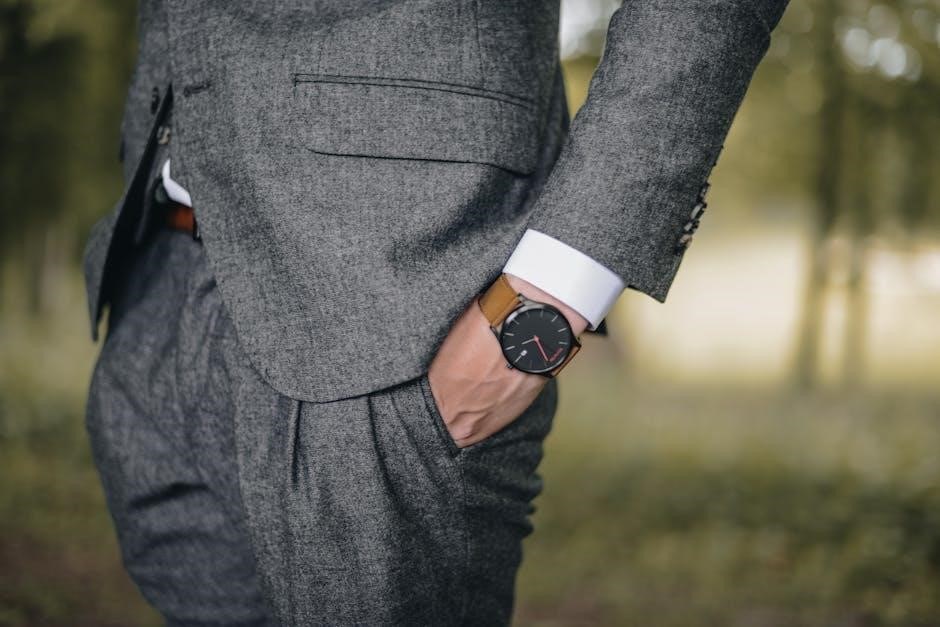
Measuring for the Perfect Fit
Use a flexible tape measure to determine your waist or hip size‚ ensuring a snug fit. Measure where the belt will be worn for accuracy and comfort.
Using a Tape Measure for Accuracy
For precise measurement‚ wrap a flexible tape measure around your natural waistline or hip area‚ where the belt will sit. Ensure the tape is snug but not tight. Note the inch measurement‚ as this will guide your belt size selection. For men‚ add 2 inches to your waist size for the ideal fit. For women‚ consider whether you’ll wear the belt at the waist‚ hips‚ or in between. This method ensures a comfortable and secure fit‚ avoiding the guesswork of relying solely on pant size. Accurate measurement is key to choosing the perfect belt size.
Measuring an Existing Belt
To measure an existing belt‚ lay it flat and straighten it out. Start from the buckle’s fold point and measure to the most frequently used hole. This length will determine your ideal belt size. Ensure the belt is taut for accuracy. If the measurement falls between sizes‚ round up to ensure comfort. For example‚ if your measurement is 36.5 inches‚ choose a 38-inch belt. This method is reliable and eliminates guesswork‚ especially when replacing a well-fitting belt. It also accounts for any stretch or wear‚ ensuring your new belt fits perfectly from the start.
How to Measure Your Waist or Hips
Measuring your waist or hips is essential for accurate belt sizing. Use a flexible tape measure and wrap it snugly around the area where the belt will sit. For low-waist pants‚ measure at the hip’s fullest point. For high-waist styles‚ measure the narrowest part of your waist. Ensure the tape is level and not twisted for precise results. Add 1-2 inches to this measurement for comfort and functionality‚ especially if the belt is for casual wear. This method ensures a tailored fit‚ whether you’re wearing jeans or formal attire‚ and helps you select the perfect belt size effortlessly. Consistency is key for the best results.
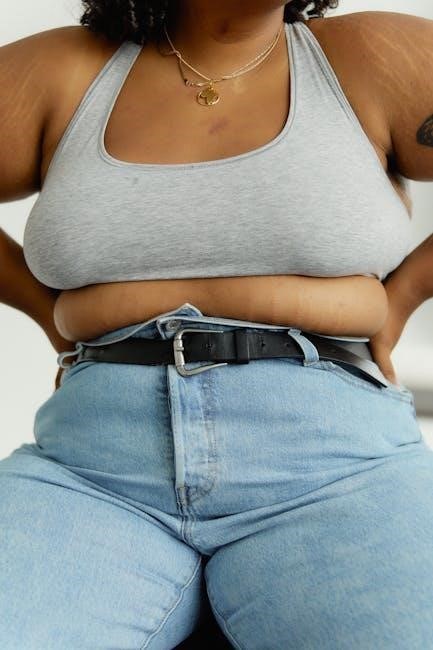
Choosing the Right Belt Size
Measure your waist or hips with a tape measure for accuracy. Add 1-2 inches for comfort‚ ensuring the belt fits snugly without being too tight or loose.
Using a Belt Size Chart
A belt size chart is a practical tool for determining the perfect fit. It typically correlates waist measurements with corresponding belt sizes‚ ensuring accuracy. By referencing the chart‚ you can match your measured waist or hip size to the appropriate belt length. This method eliminates guesswork‚ especially when shopping online. Most charts provide standard ranges‚ such as 30 to 50 inches for men and similar scales for women. Ensure the chart aligns with the brand’s sizing‚ as variations may occur. Using a chart helps you select a belt that fits comfortably and securely‚ avoiding the need for adjustments later;
Adding Inches for Comfort and Fit
Adding inches to your waist measurement ensures a comfortable and functional fit. For men‚ adding 2 inches to your pant size is a standard rule of thumb‚ while women may add 1-2 inches‚ depending on whether the belt is worn at the waist or hips. This extra length allows for a snug yet relaxed fit‚ preventing the belt from feeling too tight. It also accounts for potential stretch in materials like leather over time. By incorporating this adjustment‚ you ensure the belt sits securely without restricting movement‚ providing both comfort and practicality for everyday wear.
Considering Belt Material and Stretch
Belt material and stretch are key factors in sizing. Leather belts‚ for instance‚ may stretch over time‚ so selecting a size that allows for this natural give is essential; Synthetic materials‚ like nylon or polyester‚ offer less stretch‚ requiring a more precise fit. Adjustable belts or those with multiple holes provide flexibility‚ accommodating minor size fluctuations. When choosing a belt‚ consider both the material’s durability and how it will conform to your body. This ensures a comfortable‚ long-lasting fit that adapts to your needs without compromising style or functionality.
Factors Influencing Belt Size
Belt size is influenced by weight‚ body type‚ height‚ and proportions. Taller individuals may prefer wider belts‚ while shorter people opt for narrower styles to balance their frame.
Weight and Body Type
Your weight and body type significantly impact belt size. Heavier individuals may require larger sizes for comfort‚ while those with slimmer builds might prefer smaller belts. Body shape also plays a role; for example‚ someone with a larger midsection may need a longer belt to accommodate their waistline. Additionally‚ the distribution of body fat can affect how a belt fits‚ making it essential to consider these factors when choosing the right size. Proper fit ensures both comfort and functionality‚ preventing issues like digging or slipping.
Height and Proportions
Height and proportions play a role in choosing the right belt size. Taller individuals may prefer wider belts to balance their frame‚ while shorter people should opt for narrower belts to avoid overwhelming their silhouette. Proportions matter too; taller individuals can handle larger buckles and wider styles without looking disproportionate. Conversely‚ shorter individuals benefit from sleeker‚ more streamlined belts. Balancing height with belt width ensures a harmonious look‚ enhancing both style and comfort. Consider these factors to find a belt that complements your physique and maintains a polished appearance.
Belt Style and Buckle Size
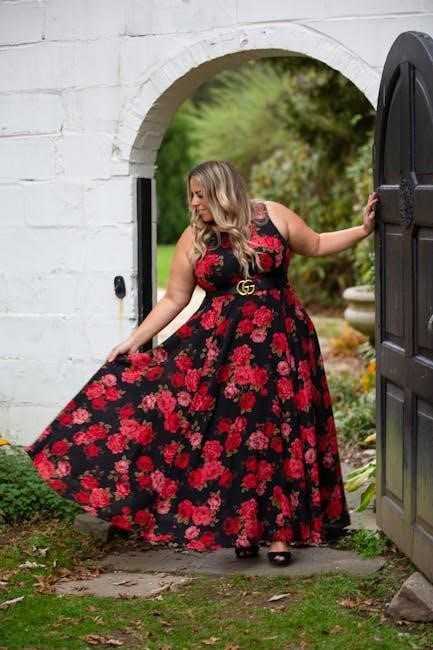
Belt style and buckle size significantly impact both functionality and aesthetics. The buckle size should complement the belt’s width and your outfit. Larger buckles suit wider belts and casual styles‚ while smaller‚ minimalist buckles are ideal for formal or slim-fit designs. The buckle’s “throw” (distance from the prong to the bale) affects how the belt sits and fastens. Choose a belt style that matches your outfit’s formality‚ ensuring the buckle enhances rather than overwhelms the look. Coordinating the buckle with your shoes or accessories adds polish‚ while the belt’s width should proportionally match your pants or waist size for a balanced appearance.

Selecting the Perfect Belt
Choosing the ideal belt involves balancing style‚ comfort‚ and functionality. Consider belt width‚ buckle design‚ and material to ensure a seamless match with your outfit and personal taste.
Width of the Belt
The width of a belt significantly impacts both comfort and style. Wider belts‚ such as 1.5 inches or more‚ suit taller individuals‚ balancing proportions‚ while narrower belts (1 inch or less) are ideal for shorter frames. Material thickness also matters; thicker belts require wider designs for durability. For formal outfits‚ narrower belts are preferred‚ whereas casual looks often pair well with wider styles. Consider the buckle size and overall aesthetic when choosing width. Coordinating the belt width with your shoes and outfit ensures a cohesive look. Ultimately‚ the right width enhances both functionality and visual appeal‚ making it a key factor in belt selection.
Buckle Style and Fit
Buckle style and fit are essential for both functionality and fashion. Choose a buckle that complements your outfit; minimalist designs suit formal attire‚ while elaborate buckles enhance casual looks. The buckle’s size and throw—distance from the bale to the prong—affect the belt’s functionality. Ensure the buckle aligns with your body type; larger buckles may overwhelm smaller frames. Proper fit ensures comfort and prevents excessive tightness. Coordinating the buckle with shoes and accessories creates a harmonious look. Selecting the right buckle style enhances the belt’s aesthetic and ensures a polished appearance‚ making it a vital element in completing your outfit.
Matching Belt to Outfit and Shoes
Matching your belt to your outfit and shoes ensures a cohesive‚ stylish look. Coordinate the belt’s color and material with your shoes for a polished appearance. For formal outfits‚ opt for a sleek belt that mirrors your footwear’s finish. Casual looks allow for more versatility‚ but maintaining a harmonious color scheme enhances the overall style. Consider the occasion and outfit’s formality when selecting the belt. A well-chosen belt ties together the ensemble‚ creating a balanced and intentional aesthetic that elevates your entire look.

Special Considerations
Special considerations in belt sizing include accommodating plus sizes‚ ensuring proper fit for children‚ and customizing belts for unique needs or preferences. Accuracy and comfort are key.
Belt Sizing for Plus Sizes
Belt sizing for plus sizes requires attention to comfort and flexibility. Measure around the natural waistline or where the belt will sit‚ ensuring the tape is snug but not tight. Add 1-2 inches to this measurement for a comfortable fit. Consider wider belts for better distribution of pressure and support. Elastic or stretchable materials can provide added comfort. When using a belt size chart‚ ensure it caters to plus sizes‚ as standard charts may not account for larger measurements. Proper sizing ensures both functionality and confidence‚ making it essential to choose belts designed for your body type.
Belt Sizing for Children
Belt sizing for children involves measuring their waist or hip area accurately. Use a flexible tape measure to determine where the belt will sit‚ typically around the natural waistline. Add 1-2 inches for comfort. Choose belts with adjustable buckles for growth. Consider the width based on the child’s height and proportions—narrower belts suit smaller frames. Refer to size charts designed for children‚ as adult charts may not apply. Ensure the belt is snug but not restrictive‚ allowing for movement. Proper sizing ensures comfort and practicality‚ adapting to their changing sizes as they grow.
Custom and Specialty Belts
Custom and specialty belts cater to unique preferences and needs. These belts are tailored to specific measurements‚ materials‚ or styles. For instance‚ specialty belts may feature interchangeable buckles or decorative elements. When ordering custom belts‚ precise measurements are essential—measure from the buckle fold to the most-used hole for accuracy. Consider materials like exotic leathers or nylon for durability. Specialty belts‚ such as ranger belts‚ combine narrow and wide straps to showcase buckles. Custom orders often allow for specific widths‚ lengths‚ and finishes‚ ensuring a perfect fit and personalized style. This option is ideal for those seeking one-of-a-kind accessories that stand out.

Belt Size Charts and Conversion
Belt size charts provide a standardized guide for determining sizes‚ often converting inches to centimeters. These charts help ensure accurate fit and compatibility across international sizing differences.
Standard Size Charts Explained
Standard belt size charts provide a consistent reference for determining belt sizes‚ typically ranging from 30 to 50 inches. These charts are designed to align with common waist measurements‚ offering even-sized options (e.g.‚ 30‚ 32‚ 34) and occasionally accommodating odd sizes. To use a size chart‚ measure your waist or hips where the belt will sit‚ then compare the measurement to the chart. Most charts recommend adding 1-2 inches to your waist size for comfort. For accuracy‚ use a flexible tape measure and ensure the belt lies flat. Buckle throw and material stretch should also be considered for the best fit.
Converting Inches to Centimeters
Converting belt sizes from inches to centimeters is essential for international compatibility. To convert‚ multiply the inch measurement by 2.54 (e.g.‚ 30 inches = 76.2 cm). Standard belt sizes in inches (e.g.‚ 30–50) translate to centimeters as 76–127 cm. Use a flexible tape measure to determine your waist or hip size‚ then apply the conversion factor; Accurate measurements ensure a proper fit‚ whether using inches or centimeters. Refer to size charts for precise conversions‚ as slight variations may exist between brands. This guide helps you choose the right belt size globally‚ ensuring comfort and style across different regions and sizing standards.
International Belt Size Differences
Belt sizes vary internationally‚ with different regions using unique measurement systems. In Europe‚ sizes are often labeled in centimeters‚ while in the U.S.‚ inches are standard. Some countries adopt a “one-size” approach with adjustable belts. Understanding these differences is crucial for global shoppers. For instance‚ a 34-inch belt in the U.S. may equate to a 86 cm belt in Europe. Always refer to conversion charts or regional sizing guides to ensure accuracy. Accurate measurements and conversions are key to selecting the right belt size across borders. This ensures a proper fit and avoids sizing discrepancies when shopping internationally.

Common Mistakes to Avoid
- Assuming pants size equals belt size without measuring.
- Not accounting for belt stretch or material flexibility.
- Ignoring buckle throw measurement‚ affecting fit accuracy.
Assuming Pants Size Equals Belt Size
A common mistake is believing pants size directly translates to belt size. While they are related‚ differences in materials‚ styles‚ and body measurements mean they don’t always align. Pants sizes vary by brand‚ fit‚ and design‚ so relying solely on this can lead to an ill-fitting belt. For instance‚ a 32-inch waist in pants might require a 34-inch belt due to added inches for comfort. Always measure your waist or an existing belt to ensure accuracy‚ as pants size is merely a starting point‚ not a definitive guide for choosing the right belt size.

Not Accounting for Belt Stretch
Ignoring belt stretch is a common oversight that can lead to a poor fit. Belts‚ especially those made of leather or elastic materials‚ naturally stretch over time. Failing to account for this can result in a belt that becomes too loose‚ losing its functionality and comfort. To avoid this‚ consider the material’s potential for stretch when selecting a size. For example‚ leather belts may require a slightly smaller initial size to accommodate future stretching. Always measure an existing belt or add a small margin to your waist measurement to ensure a proper fit that remains comfortable and secure over time.
Ignoring Buckle Throw Measurement
Overlooking the buckle throw measurement can lead to an ill-fitting belt. The buckle throw refers to the distance from the buckle’s attachment point to where it secures the belt. Different buckles‚ such as one-piece or trophy styles‚ can have varying throws‚ affecting the overall fit. If not accounted for‚ the belt may be too tight or too loose‚ compromising both comfort and functionality. Always measure the buckle throw when sizing a belt‚ especially with unique or larger buckles‚ to ensure the belt sits comfortably and securely. This step is crucial for achieving the perfect fit and avoiding sizing errors.
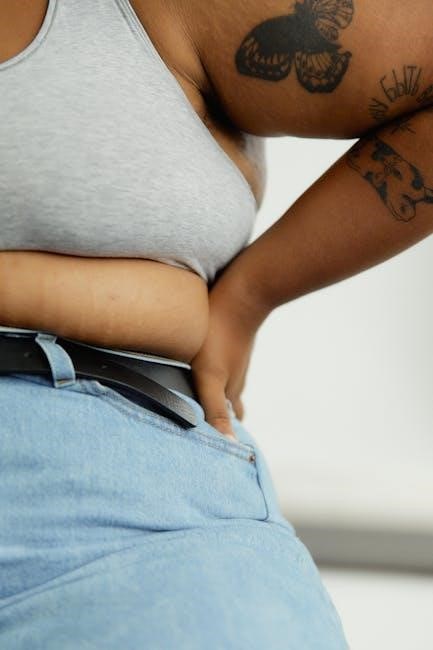
Caring for Your Belt
Regular cleaning and conditioning are essential to maintain your belt’s quality. Store it in a cool‚ dry place to prevent damage and ensure longevity.
How to Clean and Maintain Your Belt
To keep your belt looking its best‚ clean it regularly with a mild soap solution for fabric belts or a leather conditioner for leather belts. Avoid harsh chemicals or excessive water‚ as they can damage materials. For drying‚ allow the belt to air dry naturally rather than using heat. Store belts in a cool‚ dry place‚ away from direct sunlight‚ to prevent fading or cracking. For leather belts‚ apply a leather conditioner periodically to maintain suppleness and prevent dryness. Avoid folding belts to prevent creases; instead‚ roll or hang them. Regular maintenance ensures your belt remains durable and retains its appearance over time.
Storing Belts Properly
Proper storage is essential to maintain the quality and shape of your belts. To avoid creases or bends‚ store belts flat or rolled in a cool‚ dry place. Avoid exposure to direct sunlight‚ as it can cause fading or cracking‚ especially for leather belts. Use a protective cloth or pouch to prevent dust accumulation. For belts with buckles‚ ensure they are securely fastened to prevent scratching. Hanging belts on a sturdy rack can help maintain their shape and prevent tangling. Regularly inspect stored belts for signs of wear or damage and address them promptly to extend their lifespan. Proper storage ensures belts remain in excellent condition for years.
